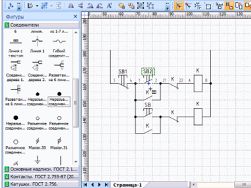
Programma Dlya Risovaniya Shem
Model your app's architecture • • 7 minutes to read • Contributors • • • • • • In this article To help ensure that your software system or application meets your users' needs, you can create models in Visual Studio as part of your description of the overall structure and behavior of your software system or application. Using models, you can also describe patterns that are used throughout the design. These models help you understand the existing architecture, discuss changes, and communicate your intentions clearly.
Save or not element label, information and conductor text with copy and paste.
To see which editions of Visual Studio support this feature, see. The purpose of a model is to reduce the ambiguities that occur in natural-language descriptions, and to help you and your colleagues to visualize the design and to discuss alternative designs. A model should be used together with other documents or discussions. By itself, a model does not represent a complete specification of the architecture. Note Throughout this topic, 'system' means the software that you are developing.
It might be a large collection of many software and hardware components, or a single application, or a part of an application. The architecture of a system can be divided into two areas: •. This describes the major components and how they interact with one another to fulfill each requirement. If the system is large, each component might have its own high-level design that shows how it is composed of smaller components. • and conventions used throughout the designs of the components.
A pattern describes a particular approach to achieving a programming goal. By using the same patterns throughout a design, your team can reduce the cost of making changes and developing new software.
High-level Design A high-level design describes the major components of your system and how they interact with one another to achieve the goals of the design. The activities in the following list are involved in developing the high level design, although not necessarily in a particular sequence. If you are updating existing code, you might begin by describing the major components. Make sure you understand any changes to the user requirements and then add or modify interactions between the components. If you are developing a new system, begin by understanding the main features of the users' needs. You can then explore sequences of interactions for the main use cases, and then consolidate the sequences into a component design. In every case, it is helpful to develop the different activities in parallel, and to develop code and tests at an early stage.
Avoid trying to complete one of these aspects before you start another. Typically, both the requirements and your understanding of the best way to design the system will change while you are writing and testing the code. Therefore, you should begin by understanding and coding the main features of the requirements and your design. Fill in the details in later iterations of the project.
The starting point of any design is a clear understanding of the users' needs. The choices you made about core technologies and architectural elements of the system. • Data Model of the Components and Interfaces. You can draw class diagrams to describe the information that is passed between components and stored inside the components. Understanding the Requirements The high-level design of a complete application is most effectively developed together with a requirements model or other description of the users' needs. For more information about requirements models, see. If the system that you are developing is a component in a larger system, part or all of your requirements might be embodied in programmatic interfaces.
The requirements model provides these essential pieces of information: • Provided interfaces. A provided interface lists the services or operations that the system or component must provide to its users, whether they are human users or other software components. • Required interfaces. A required interface lists the services or operations that the system or component can use. In some cases, you will be able to design all these services as part of your own system. Dangerous liaisons novel.
In other cases, especially if you are designing a component that can be combined with other components in many configurations, the required interface will be set by external considerations. • Quality of service requirements. The performance, security, robustness, and other goals and constraints that the system must meet. The requirements model is written from the point of view of your system's users, whether they are people or other software components. They know nothing of the internal workings of your system. By contrast, your goal in an architectural model is to describe the internal workings and show how they meet the users' needs.